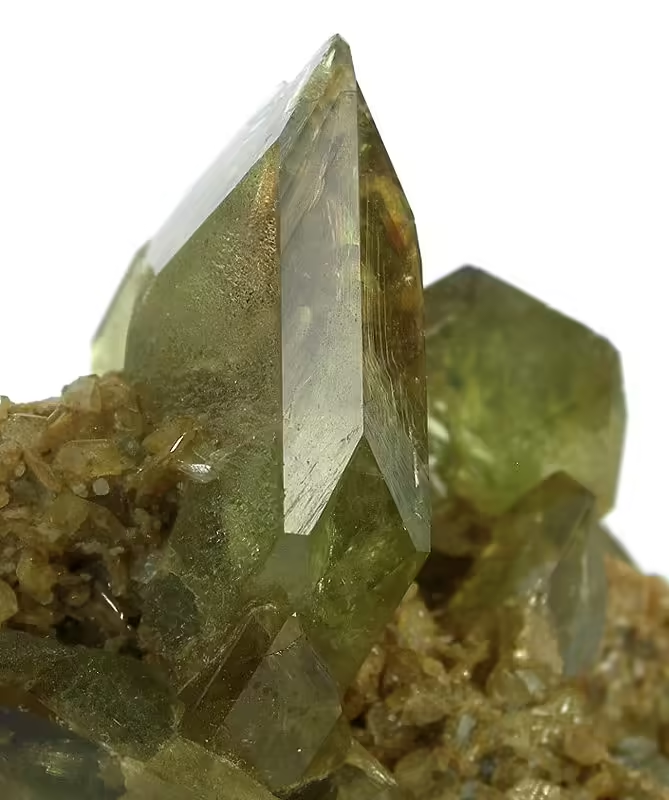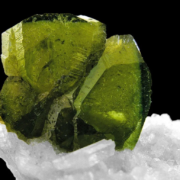Sphene (titanite): Properties, Uses and Virtues
Sphene, also known as titanite, is a common component of various rocks and a rare gem for collectors. With a more intense fire than diamond but a hardness of 5.5 on the Mohs scale, and distinct cleavage, it is easy to damage. Coloured yellow, brown, green, colourless, orange, pinkish-red or black, this gem is rarest in its chrome version, which shows an emerald green, and polychroism is not uncommon. Often associated with mental clarity, sphene is often included and it is very rare to find perfectly clear stones cut to the right size.

Sphene Geological Formation
Sphene, also known as titanite, is a gemstone that forms in a variety of geological environments, often associated with metamorphic rocks such as gneiss and marble. Its formation is the result of complex geological processes involving the presence of titanium and silicate under specific temperature and pressure conditions.
Rough Sphene – The crystalline beauty of the earth
Sphene is distinguished by its characteristic prismatic crystals, which are often flat and angular. They can also be found in massive form (clusters of micro-crystals). These crystals are often highly dispersive, which means that they scatter light spectacularly, creating flashes of bright, sparkling colour, a phenomenon known as ‘fire’.
Sources – The global presence of sphene
Sphene is widespread throughout the world, with significant deposits in Europe, Asia, North America and Africa. Examples of major deposits can be found in Madagascar, Canada, Mexico, Brazil and India.
History of Sphene – Through the ages
The first name for titanite dates back to the 18th century and is attributed to Martin Klaproth.
Unfortunately, there are not many studies on the use of sphene or titanite in jewellery over the centuries.
Today, sphene is still used in jewellery to create unique and dazzling pieces. It is appreciated for its rarity and its fire, which is more intense than that of a diamond.
Metaphysical properties of Sphene
On a metaphysical level, sphene is often associated with mental clarity, inner strength and spiritual growth. It is said to stimulate the intellect, promote concentration and help overcome mental obstacles.
Varieties of Sphene
There are no distinct gemmological varieties of sphene. It is, however, part of an extended geological family.
Sphene colors
Sphene can display a range of colours, from yellow, brown, green, orange, pinkish red, grey, colourless and even black, with variations in hue and saturation. The emerald green colour of chrome sphene is the most sought-after and the rarest.
Sphene has a strong internal fire and ‘glows’ more intensely than diamond. It also has a strong pleochroism that causes the stone to change colour depending on the angle at which it is viewed.
Durability and portability of sphene
Sphene is relatively soft, with a hardness of 5.5 on the Mohs scale, making it suitable for use in jewellery if the stone is well protected. However, it is very fragile and prone to breakage, so care must be taken.
Sphene enhancements
Sphene can be heat treated to improve its colour. It is possible to make sphene red or orange using this process.
Synthetic Sphene
Sphene, or titanite, was synthesized for research purposes. However, it is not available on the market.
Sphene Imitations
CZ and red garnets were used to imitate sphene, as was zircon. The garnets imitate the colour, while the CZ and zircon imitate the fires that are very present inside the stone.
Conversely, sphene can be used to imitate the highly sought-after demantoid garnet.
Caring for sphene
To preserve the beauty of the sphene, we recommend cleaning it regularly with a soft cloth and lukewarm water. Avoid harsh chemicals and store it separately from other jewellery to avoid scratches.



Leave a Reply
Want to join the discussion?Feel free to contribute!